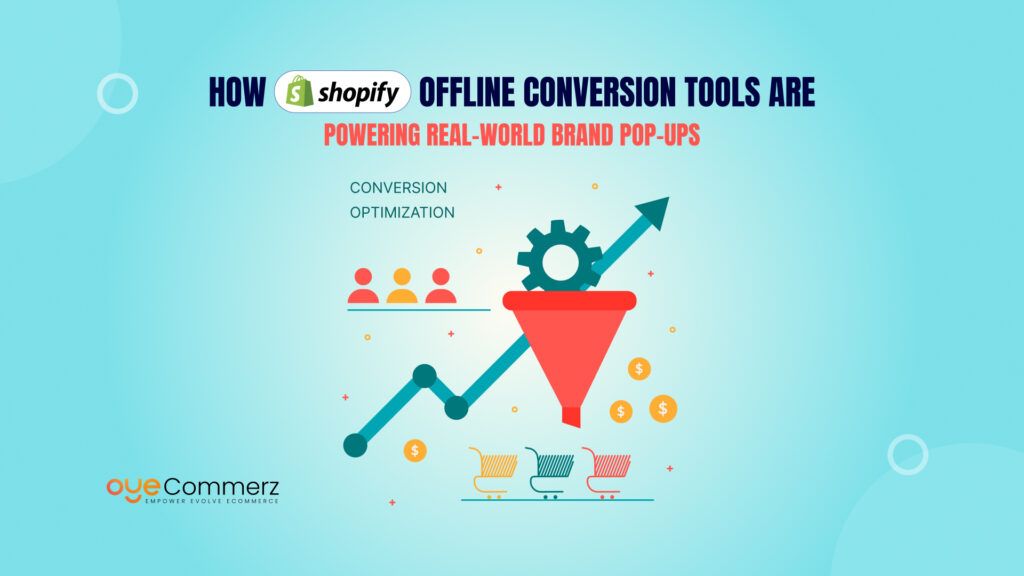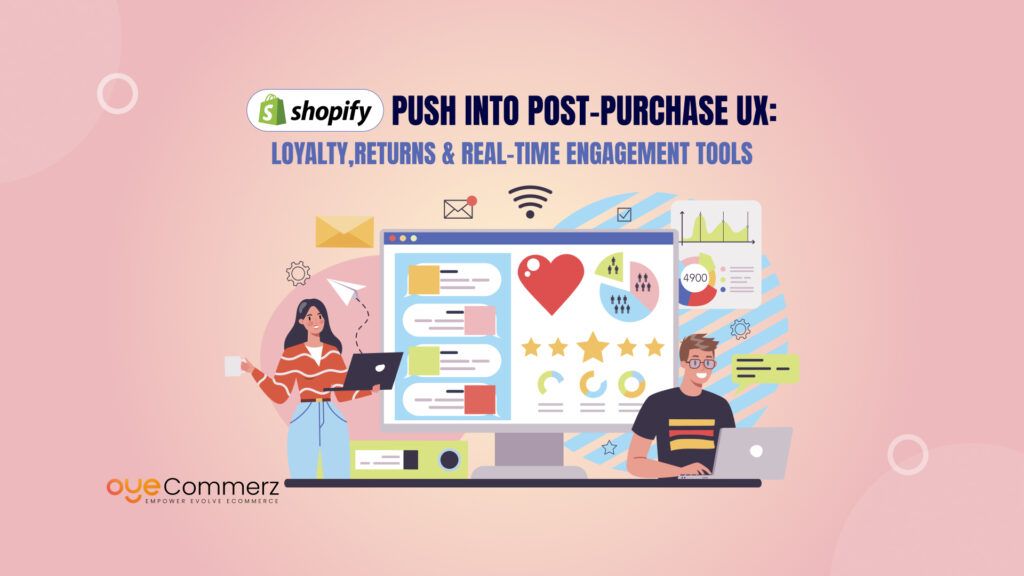Is AliExpress still the right sourcing partner for your Shopify brand in 2025?
What once worked for early-stage dropshippers is now becoming a liability. As consumer expectations evolve, U.S. shoppers are demanding faster delivery, higher product quality, and consistent customer service. Unfortunately, AliExpress often falls short. Over 65% of American consumers abandon purchases due to slow shipping, and 58% return items because of quality concerns, issues commonly linked with AliExpress suppliers.
These friction points don’t just affect conversions, they damage brand trust, increase refund rates, and stunt long-term growth.
It’s time to move from AliExpress to alternatives that offer streamlined fulfillment, local warehousing, and scalable logistics. Shopify’s expanding ecosystem now supports vetted supplier apps and private label options that elevate customer experience. If you’re aiming for real growth, the switch isn’t optional, it’s essential.Let’s explore when and how to make the shift with the help of Shopify services that simplify sourcing, fulfillment, and automation.
The Cracks Are Showing- Why AliExpress Is Losing Favor Among Shopify Merchants
AliExpress has played a key role in enabling low-investment dropshipping on Shopify. But as consumer demands evolve and operational standards rise, this once-reliable source is beginning to show serious limitations. U.S.-based Shopify merchants in particular are facing recurring challenges that can no longer be ignored.
Here’s why many brands are actively seeking better supply chain options:
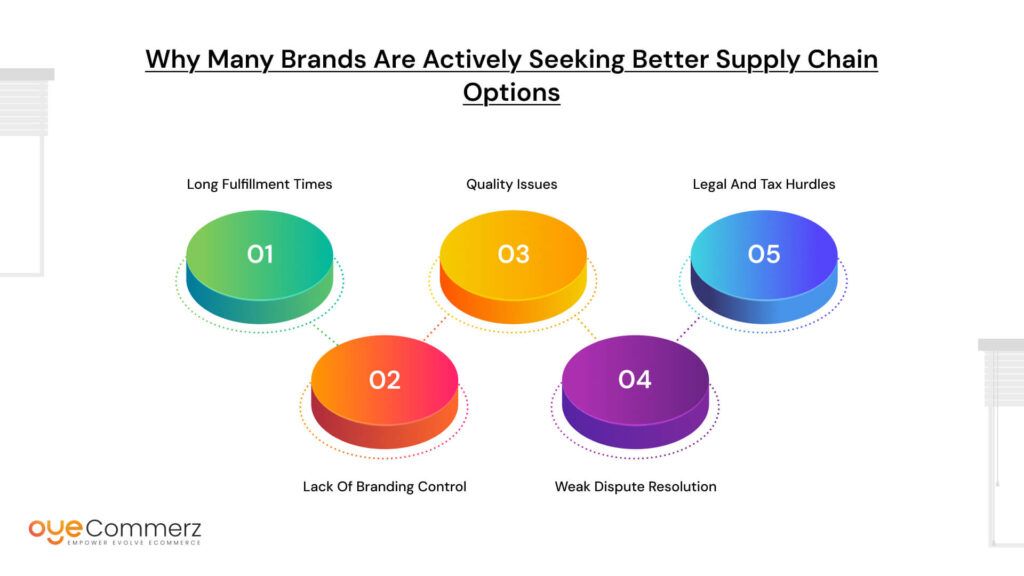
Long Fulfillment Times:
Shipping delays of 20–30 days have become the norm when ordering from AliExpress. In today’s Amazon-primed market, these timelines are unacceptable to American consumers who expect 3–7 day delivery.
Lack of Branding Control:
Merchants have little to no say in packaging, labeling, or unboxing experience. This makes it nearly impossible to build a memorable or cohesive brand.
Quality Issues:
Inconsistent product quality leads to high return rates and low customer satisfaction. The cost of refunds, lost trust, and negative reviews can cripple a store’s reputation.
Weak Dispute Resolution:
Customer service is largely out of your control. If an issue arises, resolution is slow and rarely favors the merchant, leading to chargebacks and additional losses.
Legal and Tax Hurdles:
U.S. businesses must navigate complex VAT rules and import documentation. AliExpress does not consistently support these requirements, increasing the risk of compliance errors.
While the model may still suit hobbyists or test stores, serious eCommerce businesses need faster, more reliable fulfillment systems that offer greater control and scalability. The smarter move? Move From AliExpress to Alternatives that are built to integrate directly with Shopify, improve delivery times, and support brand-building at every stage. The market is changing, and so should your supply chain.
The Real Cost- How AliExpress May Be Hurting Your Shopify Business
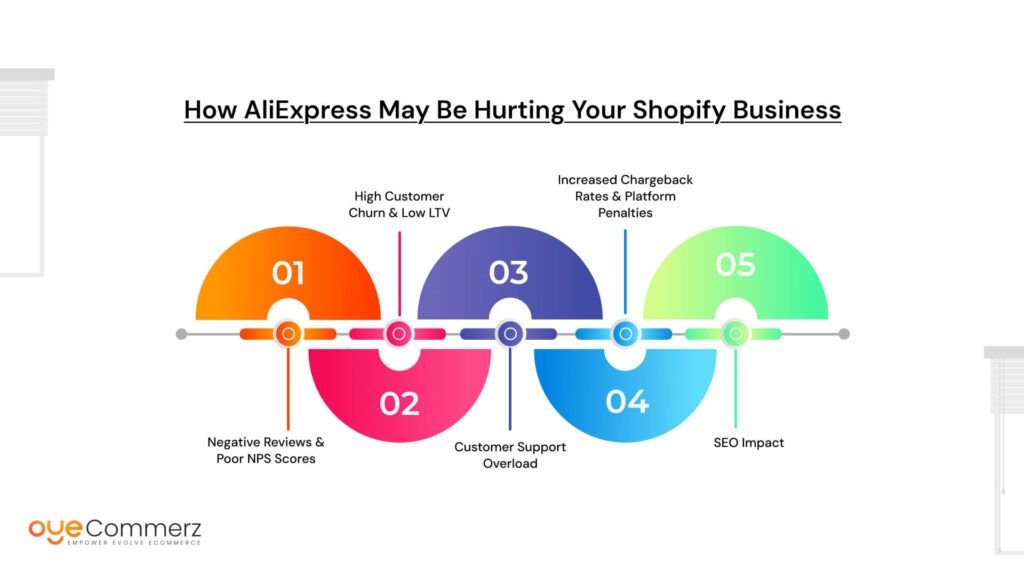
At first glance, AliExpress seems like an ideal sourcing platform: low-cost products, vast supplier variety, and no upfront inventory. But beneath that surface lies a long list of hidden costs that can quietly sabotage your Shopify brand’s growth and reputation.
Here’s what many merchants overlook until it’s too late:
Negative Reviews & Poor NPS Scores:
Slow delivery, inconsistent product quality, and poor packaging directly result in negative feedback. A poor Net Promoter Score (NPS) indicates that your customers are unlikely to recommend your brand, stunting organic growth and word-of-mouth referrals.
High Customer Churn & Low LTV:
Customers who have a bad experience rarely return. This leads to high churn rates and low Lifetime Value (LTV), forcing you to spend more on customer acquisition without building a loyal base.
Customer Support Overload:
Delayed shipping and damaged items increase support tickets significantly. Your team spends more time managing complaints, tracking packages, and issuing refunds than focusing on growth or marketing initiatives.
Increased Chargeback Rates & Platform Penalties:
When customers don’t receive products on time or are dissatisfied with quality, they initiate chargebacks. A high chargeback rate can lead to payment processor flags, held funds, or worse, account termination. Shopify also monitors seller performance, and consistently poor fulfillment metrics can lead to hidden downgrades in your store visibility.
SEO Impact:
Poor delivery experiences often lead to negative public reviews on Google and Trustpilot, which can tank your search rankings. Shopify stores with low product or service ratings may even be deprioritized in marketplaces or related search results.
Avoid platform penalties by partnering with Shopify-supported fulfillment apps that guarantee faster shipping and verified supplier networks.
Every unaddressed issue linked to AliExpress costs your business more than money, it costs you trust. To scale sustainably and maintain a competitive edge in today’s Shopify ecosystem, these pain points must be addressed early. Consider it a strategic imperative to move from AliExpress to alternatives that are smarter before these costs become irreversible.
Understanding the Shift- What Shopify Recommends for Smarter Sourcing

Shopify has evolved far beyond being just an eCommerce platform, it now plays an active role in guiding merchants toward sustainable growth. One of the biggest shifts Shopify has encouraged in recent years is how and where merchants source their products.
At the core of this shift is customer experience, and fast shipping is a non-negotiable part of that.
Conversion Rates Increase with Faster Delivery:
Shopify’s internal merchant success data reveals that stores offering 7-day shipping experience up to 30% higher conversion rates. Speed builds trust, and shoppers are far more likely to complete purchases when shipping timelines meet modern expectations.
Vetted Supplier Integrations:
To help merchants stay competitive, Shopify now supports apps that integrate directly with vetted global and local suppliers. These tools not only improve fulfillment speeds but also offer better quality control and branding options.
Smart Tools for Smarter Operations:
Apps like Shopify Flow automate repetitive tasks, reducing operational stress. Inventory Planner helps forecast demand and prevent stockouts, while Oberlo alternatives like DSers or Spocket allow merchants to filter suppliers by shipping times, reviews, and fulfillment reliability.
Platform-Driven Insights:
Shopify also offers data-driven recommendations that help merchants optimize their sourcing strategy based on order history, product returns, and customer feedback.
The message is clear: relying on slow, unverified suppliers like those found on AliExpress could mean falling behind. Merchants serious about growing a brand, not just running a store, are urged to move from AliExpress to alternatives that align with Shopify’s new standards.
The tools are there. The infrastructure is built. Now it’s about choosing the right partners that can meet your customers’ expectations without compromising your operational agility.
Top Shopify-Compatible Alternatives to AliExpress for 2025
If you’re ready to improve your Shopify store’s shipping speed, customer satisfaction, and brand image, it’s time to explore better sourcing options. Thankfully, Shopify now supports several strong alternatives to AliExpress that offer faster delivery, quality control, and more control over your brand.
Here’s a quick comparison of the top platforms:
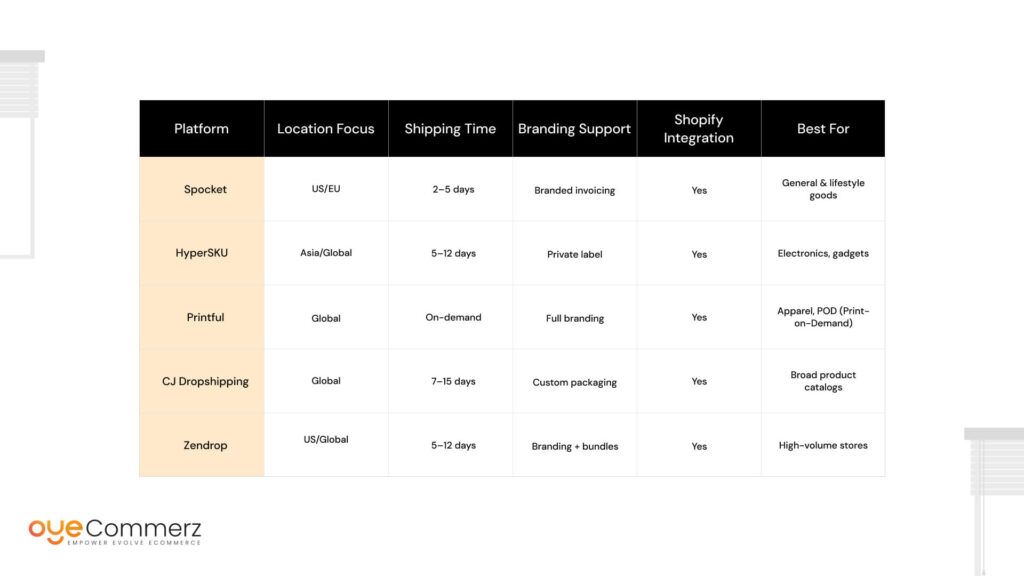
Key Features to Look For:
Fast Shipping:
Most of these platforms offer U.S. or global fulfillment within 5–12 days, some even faster.
Branding Support:
Unlike AliExpress, these suppliers allow you to add logos, custom packaging, and thank-you notes to your orders.
Easy Shopify Integration:
Each of these tools has a ready-to-use Shopify app, making it easy to connect, manage inventory, and process orders in just a few clicks.
Diverse Product Options:
Whether you sell fashion, tech gadgets, or lifestyle products, these platforms offer wide catalogs with quality control.
In 2025, your success depends on the experience you deliver. To grow faster and build trust, it’s essential to move from AliExpress to alternatives that are more aligned with your goals as a Shopify merchant.
Transitioning From AliExpress the Smart Shopify Way
Problem:
You’ve done the hard work of setting up your Shopify store, chosen products that align with your niche, and started driving traffic through ads or influencers. But the results aren’t sticking. Why? Because your customer experience is breaking down after checkout. Despite your great website and products, slow shipping, poor packaging, and inconsistent product quality from AliExpress are dragging your brand down.
Agitate:
This isn’t just a minor inconvenience, it has a snowball effect on every aspect of your business.
- You try scaling ad campaigns, but your Return on Ad Spend (ROAS) starts to dip.
- Your Facebook Pixel data becomes unreliable as delayed fulfillment leads to longer customer journeys and failed conversions.
- Customer service gets flooded with “Where is my order?” emails, refund requests, and chargebacks.
- Your store metrics take a hit, rising bounce rates, poor feedback, and falling NPS (Net Promoter Scores).
- Shopify’s system may even flag your store’s fulfillment health, limiting visibility or disabling integrations if the performance drops too low.
This leaves many merchants stuck. You’ve invested time and money but can’t scale due to backend issues caused by an unreliable supply chain.
Solution:
Shopify now offers the infrastructure and tools to transition away from AliExpress smoothly and smartly, without disrupting your store. Here’s how to make that move:
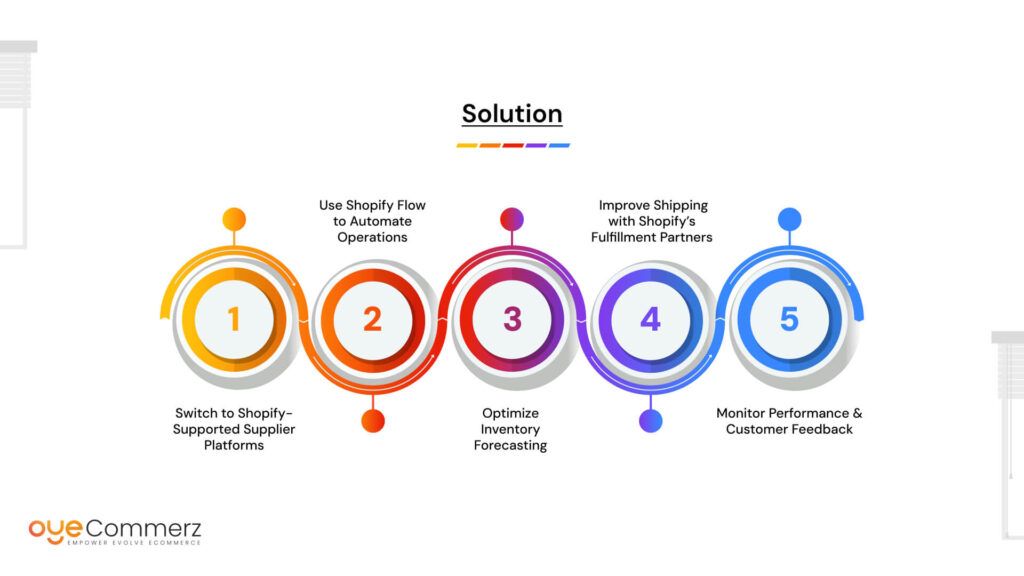
1. Switch to Shopify-Supported Supplier Platforms
Platforms like Spocket, Zendrop, CJ Dropshipping, and HyperSKU offer pre-vetted suppliers with proven shipping timelines and stronger customer service. Integration with Shopify is simple, and many of these apps support:
- Branded packaging
- Bundled products for upsells
- Live inventory sync
- Order tracking automation
2. Use Shopify Flow to Automate Operations
With Shopify Flow, you can automate workflows such as low-stock alerts, email updates for delayed shipments, and re-order triggers. This cuts down manual work and improves the buyer experience through consistency.
3. Optimize Inventory Forecasting
Use Inventory Planner to manage your inventory more intelligently. Avoid stockouts and overstocking by predicting trends using actual data from your store.
4. Improve Shipping with Shopify’s Fulfillment Partners
Shopify now supports direct integrations with logistics providers that offer 2–7 day delivery across the U.S. With options like Shopify Fulfillment Network and app-based logistics (e.g., ShipBob, Deliverr), you can offer Amazon-like speed without holding inventory yourself.
5. Monitor Performance & Customer Feedback
Make it a habit to review fulfillment analytics inside your Shopify dashboard. Look at order processing time, tracking update speed, and return reasons. Use this data to continue optimizing your supplier partnerships and reduce pain points.
Start small. Pick your highest-selling product and move it from AliExpress to a reliable alternative. Measure the impact in customer reviews, delivery speed, and conversion rate, then scale from there.
The shift isn’t just about leaving AliExpress. It’s about building a Shopify business that’s sustainable, scalable, and brand-ready. Smart merchants know the backend is just as important as the frontend, and Shopify now gives you every tool needed to get it right.
How to Migrate From AliExpress to Alternatives Using Shopify
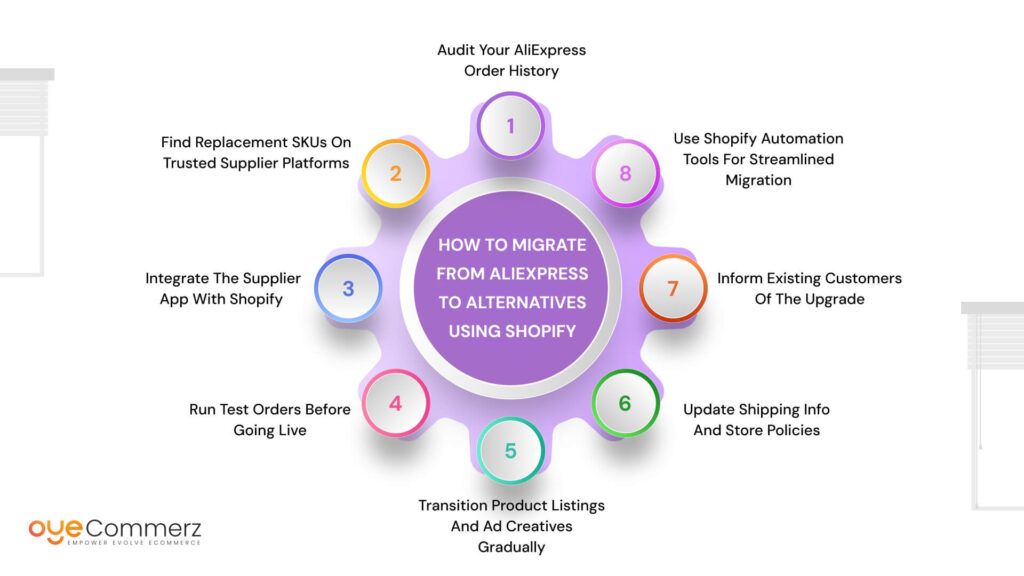
Migrating from AliExpress to better dropshipping alternatives doesn’t have to be overwhelming. Shopify’s ecosystem offers everything you need to transition smoothly, without disrupting your store’s operations or customer experience. Whether you’re trying to fix long shipping times or improve your brand image, following a structured approach will help ensure success.
Here’s a step-by-step strategy to help you make the switch efficiently and confidently:
1. Audit Your AliExpress Order History
Start by reviewing your Shopify order history linked to AliExpress. Focus on identifying:
- Best-selling products over the past 3 to 6 months
- Items with the highest return rates or complaints
- Products that regularly experience shipping delays
Use Shopify’s analytics dashboard or order export feature to quickly filter this data.
2. Find Replacement SKUs on Trusted Supplier Platforms
Once you have your target list, search for equivalent SKUs on platforms like:
- Spocket – For fast-shipping U.S. and EU products
- Zendrop – Ideal for global and high-volume fulfillment
- CJ Dropshipping – Broad product range with custom branding options
- HyperSKU – Great for gadgets and private label electronics
Ensure that the replacement product matches or exceeds your current quality and pricing.
3. Integrate the Supplier App With Shopify
Each of the above platforms offers a native Shopify app. Installing them allows you to:
- Sync product listings and pricing automatically
- Manage inventory in real-time
- Process orders directly from your Shopify dashboard
These apps minimize manual entry and reduce fulfillment errors.
4. Run Test Orders Before Going Live
Before updating your store, place test orders with your new supplier. Evaluate:
- Fulfillment speed (time from order to tracking update)
- Product quality and packaging
- Accuracy in order details and variants
Document your findings so you can confidently move forward.
5. Transition Product Listings and Ad Creatives Gradually
Rather than switching everything at once, update your best-performing listings first:
- Replace old product descriptions with details from the new supplier
- Update product images, reviews, and user-generated content
- Align ad creatives with new product visuals and USPs (Unique Selling Points)
This staged rollout avoids disrupting ad campaigns and lets you A/B test changes.
6. Update Shipping Info and Store Policies
Revise your delivery promise on the product page, FAQs, and checkout:
- Mention improved shipping times (e.g., “Delivered in 5–7 Days Across the U.S.”)
- Adjust refund/return timelines based on the new supplier’s policies
Transparent communication reduces buyer hesitation and improves trust.
7. Inform Existing Customers of the Upgrade
Send an email or post an update on your site:
“We’ve upgraded our shipping- You’ll now receive your orders faster with better tracking and packaging.”
Use it as a retention and marketing angle to re-engage old customers.
8. Use Shopify Automation Tools for Streamlined Migration
Apps like AutoDS, DSers, and Dropified help simplify the migration by:
- Bulk-importing new products
- Setting pricing rules
- Automating order routing and fulfillment
These tools allow you to maintain efficiency while scaling new supplier relationships.
A thoughtful, step-by-step transition ensures that your Shopify store not only survives the shift, but thrives with better fulfillment, branding, and customer satisfaction.
Branding & Fulfillment- The Key Differentiator in Shopify’s Ecosystem
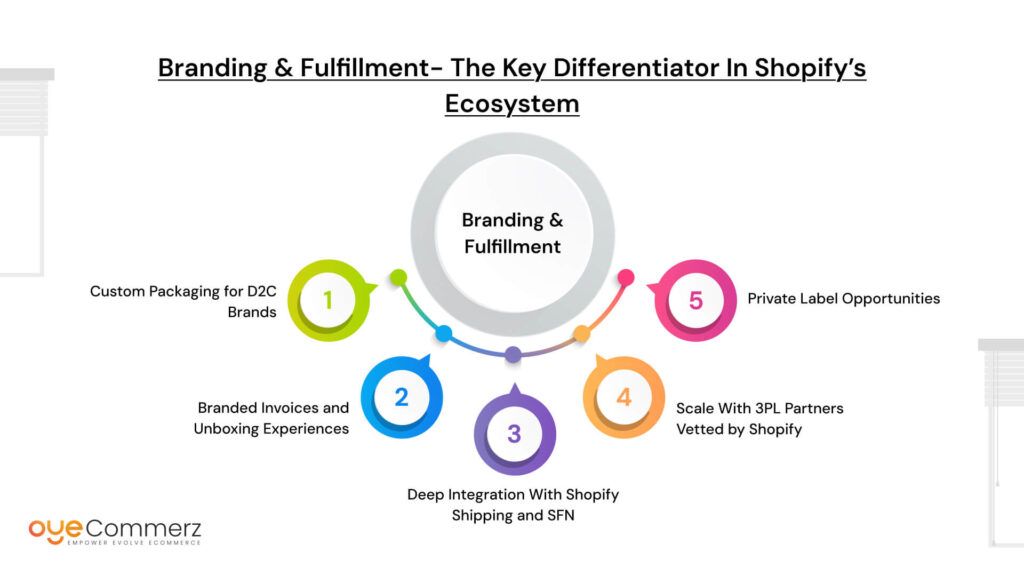
In today’s highly competitive eCommerce space, branding and fulfillment are no longer optional, they’re critical to building customer trust and loyalty. Shopify understands this shift and has evolved its ecosystem to support merchants in delivering premium, brand-first experiences at scale.
Here’s how branding and fulfillment give your store a competitive edge:
1. Custom Packaging for D2C Brands
When customers receive your product, the packaging is your first physical impression. Unlike AliExpress, Shopify-supported fulfillment partners allow:
- Custom boxes and inserts
- Thank-you cards and brand materials
- Eco-friendly packaging options
These touches elevate your perceived value and drive repeat purchases.
2. Branded Invoices and Unboxing Experiences
First impressions matter, but so do lasting ones. Branded invoices and thoughtful unboxing experiences help your store:
- Stand out from generic dropshipping packages
- Strengthen customer-brand connection
- Increase referrals and social media shares
Platforms like Printful, Zendrop, and CJ Dropshipping support these options natively with Shopify.
3. Deep Integration With Shopify Shipping and SFN
Shopify enables merchants to plug into:
- Shopify Shipping for discounted carrier rates
- Shopify Fulfillment Network (SFN) for fast U.S. warehousing and last-mile delivery
These integrations reduce delivery time and improve customer satisfaction, a massive upgrade over AliExpress’s 20–30 day delays.
4. Scale With 3PL Partners Vetted by Shopify
Shopify’s app marketplace features vetted 3PLs (Third-Party Logistics) providers, giving you:
- Reliable warehousing
- Faster processing
- Order tracking synced with your Shopify backend
These providers specialize in D2C logistics and customer-first delivery experiences.
5. Private Label Opportunities
Want to build your own brand? Shopify-compatible suppliers now offer:
- Private label manufacturing
- Local and international sourcing
- Bulk inventory storage and fulfillment
This helps you move from being just a seller to becoming a brand owner, fully aligned with Shopify’s long-term merchant vision.
Future-Proofing Your Shopify Brand Beyond AliExpress
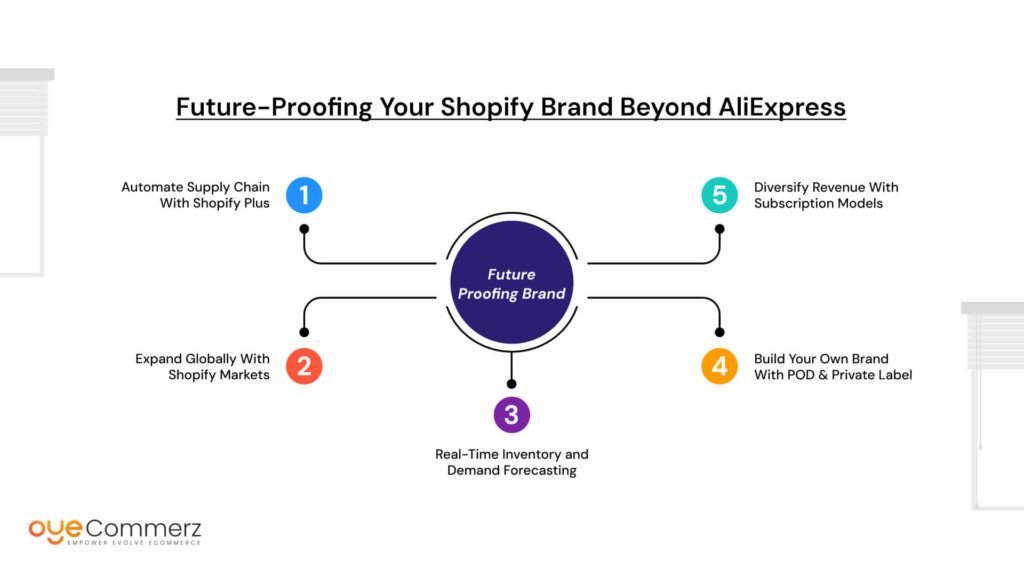
To build a resilient and scalable Shopify business in 2025, merchants must think beyond short-term tactics and focus on long-term infrastructure. One key decision? It’s time to move from AliExpress to alternatives that offer better fulfillment, branding, and automation.
Here’s how you can future-proof your Shopify store for sustainable growth:
1. Automate Supply Chain With Shopify Plus
- Shopify Plus offers advanced automation features like Shopify Flow, allowing you to streamline everything from order routing to supplier communications.
- You can automate reordering from suppliers, manage stock alerts, and reduce human error, a huge leap from AliExpress’s manual process.
2. Expand Globally With Shopify Markets
- Tap into international demand by enabling Shopify Markets, which localizes pricing, language, and checkout flow.
- Combine this with region-specific suppliers (like Spocket for the U.S. and Printful for global POD) to serve faster across borders.
3. Real-Time Inventory and Demand Forecasting
- Use tools like Inventory Planner, AutoDS, or DSers to manage and forecast inventory.
- Real-time insights reduce stockouts, optimize pricing, and align promotions with actual demand.
4. Build Your Own Brand With POD & Private Label
- Print-on-Demand platforms let you launch your own branded SKUs without upfront inventory.
- Use platforms like Printful or CJ Dropshipping to create niche products with custom branding and packaging.
5. Diversify Revenue With Subscription Models
- Reduce reliance on ads by launching subscriptions for consumables or curated bundles.
- Apps like Recharge Subscriptions integrate with Shopify to support recurring billing and retention flows.
By focusing on automation, global expansion, branding, and revenue diversity, you’re not just surviving, you’re setting up your Shopify store to thrive well beyond AliExpress.
Ready to Move From AliExpress to Alternatives?
Looking to upgrade your sourcing game and streamline your fulfillment with trusted Shopify services?
At OyeCommerz, we help growth-focused brands build scalable, branded, and reliable Shopify stores, beyond AliExpress.
From vetted supplier integrations to fulfillment automation, we’ve got your back.
Let’s future-proof your eCommerce business!
Contact to Migrate your Site to Shopify Now
Conclusion
AliExpress may have been a popular choice for early-stage dropshippers, but in today’s competitive landscape, it’s falling short. Slow delivery, poor product quality, and limited branding options are no longer acceptable in a market where customer expectations are higher than ever. To scale effectively and sustainably, it’s essential to move from AliExpress to alternatives that prioritize speed, reliability, and brand control.
Thankfully, Shopify makes this transition smoother than ever. With powerful Shopify services like Shopify Markets, Flow, and a vast ecosystem of vetted supplier apps, you can optimize fulfillment, automate inventory, and build a brand customers love. Tools like Printful, Spocket, and Zendrop offer seamless integration, enabling faster shipping and private labeling, the building blocks of a high-performing eCommerce business.
Take control of your sourcing strategy. Upgrade your operations. And deliver a customer experience that fuels long-term growth.
Frequently Asked Questions
Spocket, CJ Dropshipping, and Zendrop are major competitors, offering faster shipping, better branding, and direct Shopify integration.
Use apps like DSers or AutoDS to import products, sync inventory, and automate order fulfillment directly from AliExpress.
Alibaba is better for bulk and private-label sourcing, while AliExpress suits low-volume, test-phase dropshipping. Choose based on scale and goals.
Look for products with high ratings (4.5+), strong sales volume, and reliable suppliers with positive feedback and clear shipping timelines.
Use tools like DSers to import AliExpress products to your Shopify store, map variants, and sync pricing and inventory automatically.



